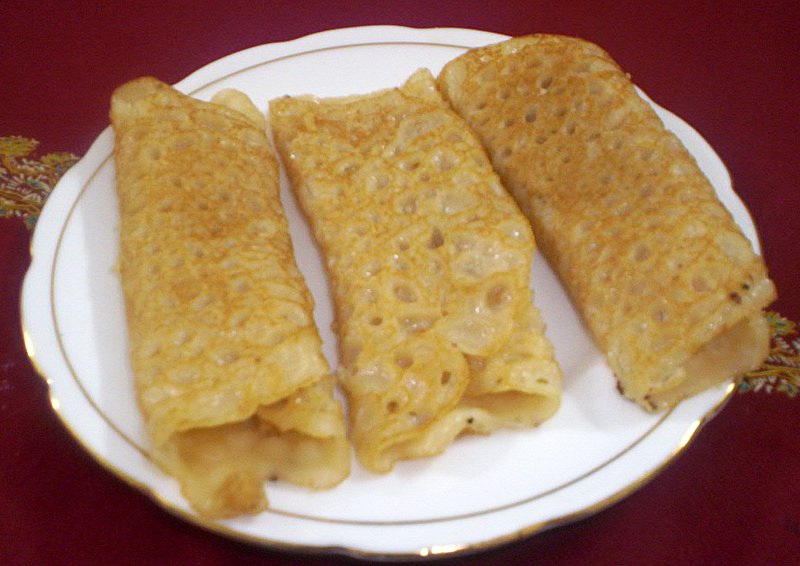As the chilly air blows around, stoves are lit all over and the atmosphere fills with the aroma of the season's delicacies, the delicious tender Pithas (rice-cakes).
No, you don’t have to wait for winter to arrive to savor these dessert delicacies of Bengal and some other eastern parts of India as these can be made and devoured any time of the year but as tradition has it, pithas are mainly made in the winter months, at the completion of harvesting, to celebrate the harvest festival of the new crop, called the Nabanna.
These festivities start from the month of November to mid December (aghrayan) and continue to from a part of the Poush Parbon (makar sankranti), the festival of the month of Poush (mid December to mid January). Climatic conditions favor one of the harvests to be held at the end of the monsoons and at this time of the year.
In India, pithas have always had an innate relationship with the winter season. Even a few years back, the pitha culture was limited only to the villages and rural areas of the country. Now this olden-day tradition has found its way out of the villages and the pitha culture has been revived in the urban areas. Nowadays pithas can be found all over, from mum's electric stove to supermarket shelves.
Pithas are cakes essentially made of rice or rice flour and in some preparations, made with wheat flour. Rice or wheat usually goes into the preparation of a pouch (khol), which are stuffed with fillings (pur) of grated coconuts and sometimes stuffed with sweetened vegetables. These pouches may be of different shapes – oval, oyster and flat shaped ones are the most common ones.
Generally, these pithes are fried (pakan pithe) or steamed (bhapa pithe). Dumplings, called puli pithe also feature among the different varieties, which include muger pulli, dudh pulli and chandrapulli. Another exclusive dessert is the patishapta, which contains sweet kheer as filling.
Some recipes use jaggery, date fruit juice or palm syrup to sweeten these pithas. Often different ingredients and spices like cashew, pistachio, cardamom and camphor are added to top up the flavor. The sweet pitha sometime go additional treatment with milk, in a payesh kind of preparation which is called the dudh pulli. These are probably the most popular sweet with the Bengali's only second that to rasogolla.
Here is a recipe of the Steamed Pitha:
Ingredients:
(10 servings)
# 500 gm rice or freshly pounded rice flour .
# 100 gm grated coconut
# 200 gm molasses (patali gur)
Method:
1. Wash and soak rice in 6 cups of water for 60-120 minutes. Drain water and spread rice in the colander, keep for 30 minutes, pound and grind rice to make flour. Sift the rice flour.
2. Assemble one small round bowl of 8 cm diameter, 3 cm deep, a piece of cotton cloth measuring 25 square centimeter, a small but deep saucepan (steamer) with a lid and a strainer that can be fitted on the saucepan.
3. Boil some water in the saucepan placing the strainer on it. Add salt to the rice flour and sprinkle some lukewarm water just to moisten the flour. Sift the flour again.
4. Spread 1 cup of rice flour lightly in the small cup. Place 1 tablespoon molasses at the center. Sprinkle 2 teaspoons coconut over it. Cover the molasses and coconut by spreading another 1 cup of rice flour in the cup. Spread a wet cloth on the cup. Gather the four corners of the cloth with the cup inside. Hold the cloth with the cup tightly keeping the cup upside down.
5. Place the cup with the cloth keeping it upside down in the strainer fitted on the saucepan. Uncover the cup and remove it carefully from the pitha.
6. Gather the corner of the cloth again and cover the pitha with it. Put lid on the saucepan and steam for 2 to 3 minutes.
7. Holding the cloth remove pitha from the strainer. Serve hot pitha at breakfast.
Here is the recipe of Patishapta:
(6 servings)
Ingredients:
# 180 grams grated fresh coconut
# 2 cups rice flour
# 3 tablespoons milk powder
# 100 gm molasses or sugar
# 1/4 cup sugar
# 1 tablespoon ghee
Method:
1. Dissolve molasses or sugar in 2 cups of water. Add rice flour and mix well, batter should be moderately thin. If necessary add a little water. Keep for 2-3 hours.
2. For the filling, mix the entire grated fresh coconut, molasses and the milk powder. Heat 1 tablespoon ghee in a pan and fry the above mixture just for 30-60 seconds and keep it aside.
3. Now, Heat the frying pan, pour in 1/4 cup of batter. Move the pan so that the batter spreads all over it. Reduce heat. When pan cake dries up place I tablespoon prepared filling at one edge.
4. Roll on the pancake. With the back of a serving spoon press the roll lightly. When sticky remove from heat. Serve as a dessert or in the breakfast.
Pithas are usually enjoyed with the sweet syrups of khejurer gur (jaggery made of dates). It is often said that the tradition of pitha is under threat with the burgeoning popularity of fast food. Being able to relish hot scrumptious pithas, while shivering in the early morning chilly mist of the countryside, is a completely different experience.
. . .
















.jpg)
No comments:
Post a Comment